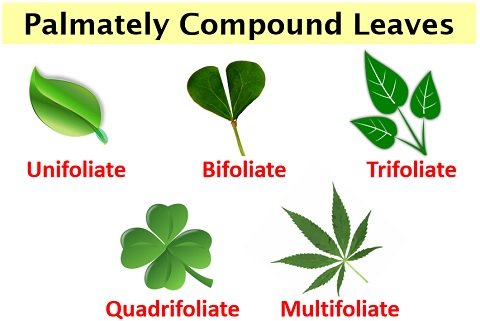The difference between simple and compound leaves is due to the factors like attachment of leaves to the leaf blade and the presence of lateral bud on the leaf’s axil. Simple leaves have the undivided or partly incised leaf blade. Conversely, compound leaves possess a variable number of leaflets on a single leaf blade.
Simple leaves bear axillary bud at their base, while leaflets of compound leaves lack axillary or lateral bud on their axil. They both are common forms of leaves in dicot plants.
Leaves constitute an essential part of the shoot system, which facilitate organic food production via photosynthesis. Leafs can modify or adapt themselves to different environments. But, simple and compound leaves are the two significant forms of leaves classified based on incisions in the leaf lamina.
This post describes the key differences between the simple and compound leaves, along with the comparison chart. Also, you would get to know the definition, types and similarities between the two.
Content: Simple Vs Compound Leaves
Comparison Chart
| Properties | Simple Leaves | Compound Leaves |
|---|---|---|
| Meaning | Simple leaves are the type of leaves where each leaf is attached to the main stem via the petiole | Compound leaves are the type of leaves where many leaflets are attached to the main stem via rachis |
| Attachment to the stem’s node | Leaves are directly attached to the stem’s node via the petiole | Leaflets are connected to the stem’s node via a short stem called the rachis |
| Stipules | Present at the leaf axil | Present at the junction between petiole and stem’s node |
| Lateral bud | All the leaves bear lateral bud at their base | Leaflets do not bear lateral buds at their base |
| Leaf-blade divisions | Leaf lamina is generally single or undivided, but the leaf margins may possess some depressions | Leaf lamina is typically divided into multiple leaflets |
| Incisions on the leaf lamina | Incisions do not reach the midrib | Incisions are deep enough to reach the midrib |
| Lamina size | Broad | Small |
| Arrangement of leaves | Arranged in acropetal succession | No such arrangement |
| Symmetry | Leaves develop in one or more planes | Leaflets grow in a one plane symmetry |
| Examples | Oak, banana, mango, maple leaves etc. | Rose, clover, neem, buckeye leaves etc. |
Definition of Simple Leaves
They are the types of dicot leaves where a single leaf attaches to the stem’s node via petiole. Each leaf bears an axillary bud at its base or between the junction of the petiole and stem’s node. The leaf margin of simple leaves can be entire, lobed and toothed. As we could see in the diagram below, the leaf lamina has no divisions.

However, a midrib may possess few incisions or depressions on a leaf margin that do not touch the midrib. Mango, banana, Hibiscus and maple leaves are examples of simple leaves.
Definition of Compound Leaves
They are the forms of dicot leaves where clusters of leaves or leaflets connect to the stem’s node via a short stalk or rachis. The base of the leaflets does not bear an axillary bud. However, axillary or lateral bud is allocated between the junction of petiole and stem’s node. The leaf margin of compound leaves can be entire, lobed, parted and rolled.
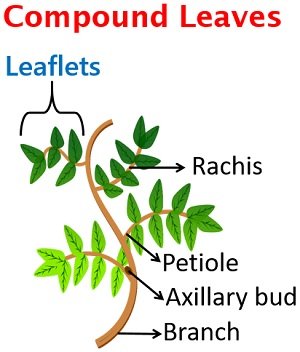
As we could see in the above diagram, the leaf lamina possesses a variable number of leaflets. Thus, a midrib is completely divided due to incisions on a leaf margin upto the midrib. Neem, rose, coriander, buckeye leaves are examples of compound leaves.
Video
Types of Simple Leaves
By looking into the leaf margins, we could also classify simple leaves. Leaf margin merely refers to the edge of leaves.
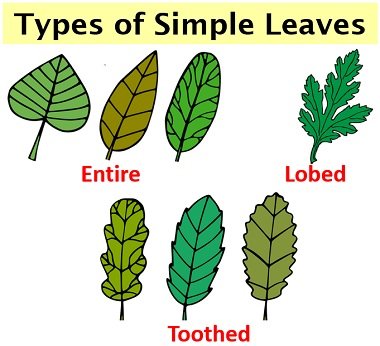
- Entire margin: Here, edges of leaves appear smooth and complete (without notches and serrations). Example: Mango leaves
- Lobed margin: Here, edges of leaves comprise many depressions and appear spiky and rounded.
Example: Oak leaves - Toothed margin: Here, the edges of a leaf are notched into irregular forms. Serrated margins appear continuous and pointed forward as in apple leaves. Dentate margins appear continuous and pointed outwards as in chestnut leaves. Lastly, crenated margins appear rounded or scalloped, as in Katsura leaves.
Types of Compound Leaves
They are broadly classified into pinnately and palmately compound leaves. Before proceeding, we must know the basic idea behind this classification. Let us look into the image below and understand the difference between the pinnately and palmately compound leaves by comparing them with the pinnately and palmately simple leaves.
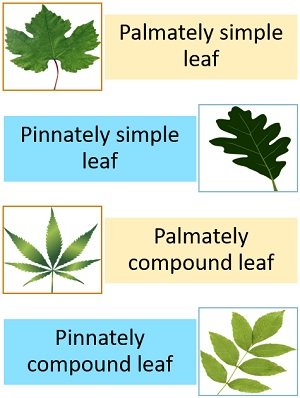
A pinnately compound leaves form when simple unicostate leaves undergo incisions at different points on the rachis. Conversely, palmately compound leaves form when divergent multicostate leaves undergo incisions towards a single point or a tip of the petiole.
Based on the number of times incision occurs, pinnately compound leaves have the following subtypes:
- Unipinnately imparipinnate: Here, one terminal leaf and paired leaflets are present, making an odd number of leaflets.
Example: Neem and rose leaves - Unipinnately paripinnate: Here, the primary rachis comprises paired leaflets without a terminal leaf, making an even number of leaflets.
Example: Tamarind and Sesbania leaves - Bipinnated: Here, leaflets appear on the primary and secondary rachis.
Example: Acacia and Mimosa leaves - Tripinnated: Here, leaflets appear on the primary, secondary and tertiary rachis.
Example: Moringa and Oroxylurn leaves - Decompound: Leaf is more than thrice pinnate as in coriander and carrot leaves.
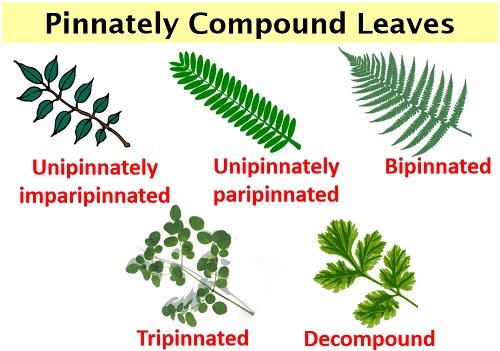
Based on the attachment of leaflets with the petiole, palmately compound leaves have the following subtypes:
- Unifoliate: At the tip of the petiole, a single leaflet is present.
Example: Lemon leaves - Bifoliate: Here, two leaflets unite at the petiole’s apex.
Example: Bauhinia leaves - Trifoliate: At the tip of the petiole, three leaflets are present.
Example: Oxalis leaves - Quadrifoliate: Here, four leaflets unite at the petiole’s tip.
Example: Marsilea leaves - Multifoliate: Here, more than four leaflets unite at the petiole’s apex.
Example: Bombax leaves
Key Differences Between Simple and Compound Leaves
- Simple leaves are the type of leaves where each leaf connects to the main stem via petiole. Oppositely, compound leaves possess many leaflets that connect to the main stem via rachis.
- Simple leaves directly attach to the stem’s node via petiole. Conversely, leaflets indirectly connect to the stem’s node via a short branch or the rachis.
- Each simple leaf bears a lateral bud at its base. In contrast, leaflets of compound leaves do not hold lateral buds at their base.
- The leaf lamina of simple leaves is generally single or undivided, but the leaf margins may possess some depressions or incisions (not so deep enough to reach the midrib). The leaf lamina of compound leaves has many divisions into multiple leaflets due to deep incisions that move down the midrib.
Similarities
- Simple and compound leaves are common in dicot plants.
- Both the forms of leaves carry out the photosynthetic activity.
- Simple and compound leaves may undergo adaptations and modifications according to the changing environment and different habitats.
- Leaf lamina and petiole are the common structures in both types of leaves.
- Both possess bud on a twig.
Conclusion
Therefore, we could conclude that simple leaves possess a single leaf blade, either entire or incised (do not touch the mid-rib or petiole). Conversely, a compound leaf has many incisions on a leaf lamina that move down to the rachis or petiole and ultimately break the leaf lamina into several segments or leaflets.
